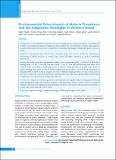 | 2021 | Environmental Determinants of Malaria Prevalence and the Adaptation Strategies in Western Nepal | Paudel, Uttam; Pant, Krishna Prasad; Adhikari, Shiva Raj; Silwal, Sashi; Baral, Bimala; Ghimire, Ghimire; Adhikari, Sabitri Devi; Paudel, Sudip; Poudyal, Anil; Dhimal, Meghnath |